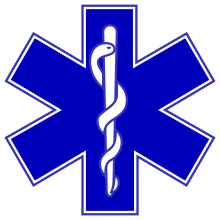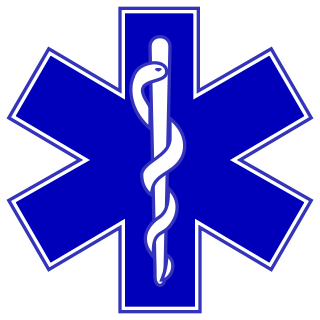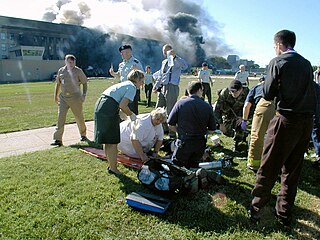
Triage is the process of determining the priority of patients' treatments based on the severity of their condition. This rations patient treatment efficiently when resources are insufficient for all to be treated immediately. The term comes from the French verb trier, meaning to separate, sift or select. Triage may result in determining the order and priority of emergency treatment, the order and priority of emergency transport, or the transport destination for the patient.

The London Ambulance Service is a NHS trust responsible for operating ambulances and answering and responding to urgent and emergency medical situations within the London region of England. The service responds to 999 and 111 phone calls, providing triage and advice to enable an appropriate level of response.

The British Columbia Ambulance Service (BCAS) is the sole ambulance service and provider of pre-hospital emergency care in the province of British Columbia. BCAS is managed by British Columbia Emergency Health Services (BCEHS) and falls under the jurisdiction of the Provincial Health Services Authority (PHSA). The service is tasked with the provision of emergency medical response province-wide. Today, BC Ambulance is among the largest Emergency Medical Services (EMS) provider in Canada and North America. The fleet consists of more than 500 ground ambulances operating from 183 stations across the province along with 80 support vehicles. BCAS provides inter-facility patient transfer services in circumstances where a patient needs to be moved between health care facilities for treatment. BCAS also operates an airevac program that utilizes both fixed-wing and rotary aircraft.

The Scottish Ambulance Service is the NHS Ambulance Services Trust, part of NHS Scotland, which serves all of Scotland's population.

The Welsh Ambulance Service, formally the Welsh Ambulance Services NHS Trust, is the national ambulance service for Wales and one of the three NHS trusts in the country. It was established on 1 April 1998 and has 2,576 staff providing ambulance and related services to the 3.1 million residents of Wales.
NHS 24 is Scotland's national telehealth and telecare organisation. This special health board runs a telephone advice and triage service that covers the out-of-hours period. The telephone service allows people who feel unwell or those caring for them to obtain health advice and information if it is not convenient or possible to wait until they can visit their general practictioner when the practice is next open. The advice line is not intended as a substitute for obtaining an emergency ambulance service via 999. The telehealth services provided by NHS Scotland fulfil some similar functions to NHS Direct Wales and the NHS 111 scheme in England.
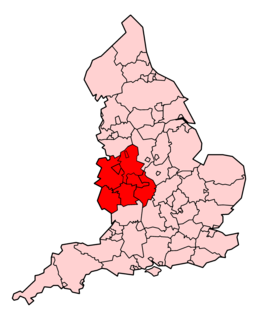
The West Midlands Ambulance Service University NHS Foundation Trust (WMAS) is the second-largest ambulance service, and the first university ambulance trust in the UK. It is the authority responsible for providing NHS ambulance services within the West Midlands region of England. The trust won the contract for non-emergency patient transport services in Cheshire, Warrington and Wirral previously provided by the North West Ambulance Service in 2015. It transferred in July 2016. The trust is currently under the leadership of chief executive Dr Anthony Marsh and chair Sir Graham Medlum OBE, OStJ. It is one of 10 Ambulance Trusts providing England with Emergency medical services, and is part of the National Health Service. There is no charge to patients for use of the service.

Hospital emergency codes are coded messages often announced over a public address system of a hospital to alert staff to various classes of on-site emergencies. The use of codes is intended to convey essential information quickly and with minimal misunderstanding to staff while preventing stress and panic among visitors to the hospital. Such codes are sometimes posted on placards throughout the hospital or are printed on employee identification badges for ready reference.
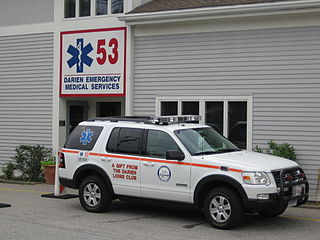
In the United States, emergency medical services (EMS) provide out-of-hospital acute medical care and/or transport to definitive care for those in need. They are regulated at the most basic level by the federal government, which sets the minimum standards that all states' EMS providers must meet, and regulated more strictly by individual state governments, which often require higher standards from the services they oversee.
Winnipeg Fire Paramedic Service (WFPS) provides Fire and EMS services to the City of Winnipeg, Manitoba. It operates from 27 Fire stations, 2 stand-alone Ambulance stations, and 3 administration offices across the city. WFPS has two equally important divisions: The Winnipeg Fire Department (WFD) and Winnipeg Emergency Medical Services (WEMS), using a centralized dispatch system.

Emergency medical services in France and Luxembourg are provided by a mix of organizations under public health control. The central organizations that provide these services are known as a SAMU, which stands for Service d'Aide Médicale Urgente. Local SAMU organisations operate the control rooms that answer emergency calls and dispatch medical responders. They also operate the SMUR, which refers to the ambulances and response vehicles that provide advanced medical care. Other ambulances and response vehicles are provided by the fire services and private ambulance services.
National Health Service Ambulance Services provide free at the point of use emergency medical care to any person requiring treatment, regardless of immigration or visitor status, within the United Kingdom. These services are provided by National Health Services of England, Scotland, Wales and Northern Ireland. The current system comprises 14 NHS organisations: 11 NHS Trusts cover the separate regions of England and; individual nationwide services cover Scotland, Wales and Northern Ireland respectively.
Disaster medicine is the area of medical specialization serving the dual areas of providing health care to disaster survivors and providing medically related disaster preparation, disaster planning, disaster response and disaster recovery leadership throughout the disaster life cycle. Disaster medicine specialists provide insight, guidance and expertise on the principles and practice of medicine both in the disaster impact area and healthcare evacuation receiving facilities to emergency management professionals, hospitals, healthcare facilities, communities and governments. The disaster medicine specialist is the liaison between and partner to the medical contingency planner, the emergency management professional, the incident command system, government and policy makers.
Emergency medical services in the Netherlands is a system of pre hospital care provided by the government in partnership with private companies.
Emergency medical services in Australia are provided by state ambulance services, which are a division of each state or territorial government, and by St John Ambulance in both Western Australia and the Northern Territory.
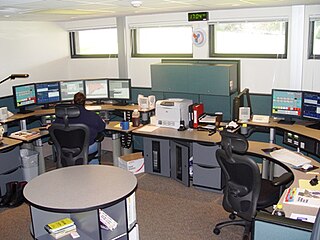
An emergency medical dispatcher is a professional telecommunicator, tasked with the gathering of information related to medical emergencies, the provision of assistance and instructions by voice, prior to the arrival of emergency medical services (EMS), and the dispatching and support of EMS resources responding to an emergency call. The term "emergency medical dispatcher" is also a certification level and a professional designation, certified through the Association of Public-Safety Communications Officials-International (APCO), the National Academies of Emergency Dispatch, and PowerPhone, Inc. Many dispatchers, whether certified or not, will dispatch using a standard Emergency Medical Dispatch protocol.

NHS Pathways is a triage software utilised by the National Health Service of the United Kingdom to triage public telephone calls for medical care and emergency medical services - such as 999 or 111 calls - in some NHS trusts and five of the ambulance services in the country. In its emergency capacity, it has replaced the Advanced Medical Priority Dispatch System for some trusts, and in non-emergency telephone triage it is found in many medical care triage systems, such as NHS 111.
